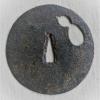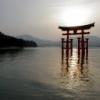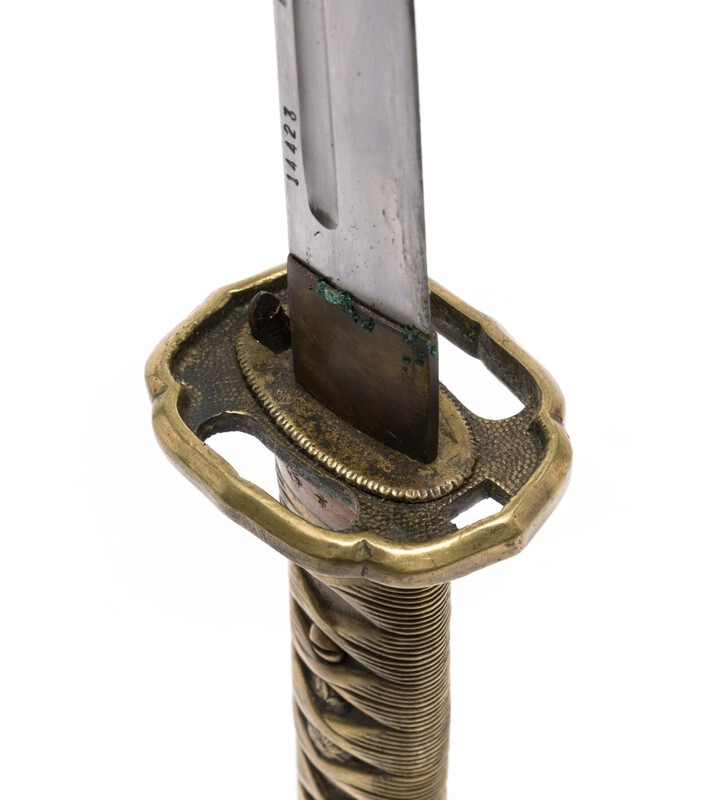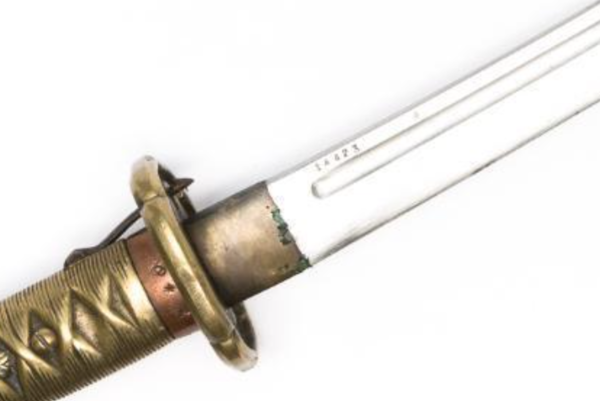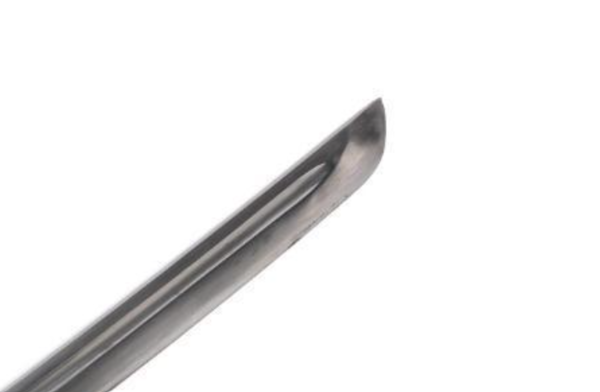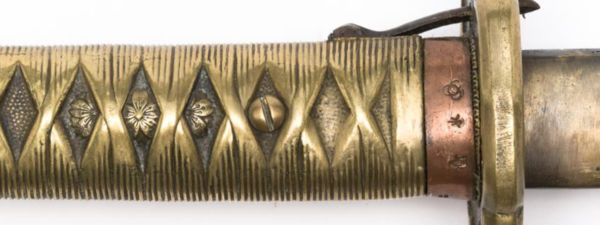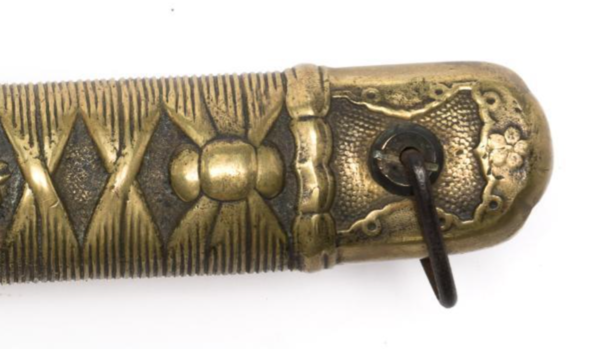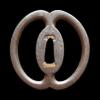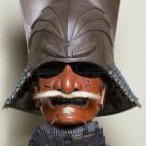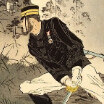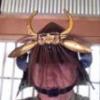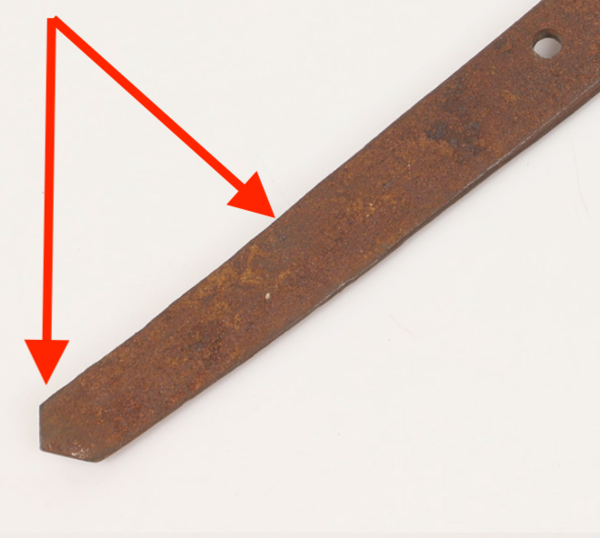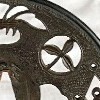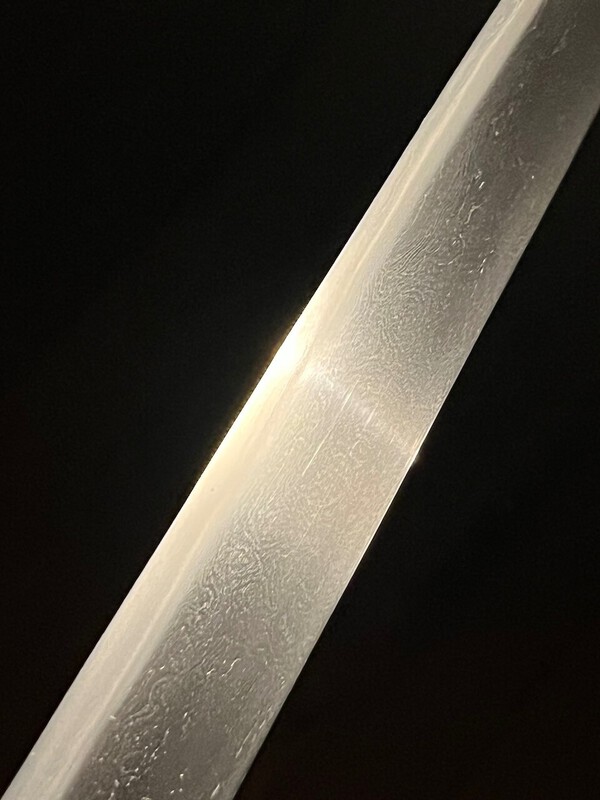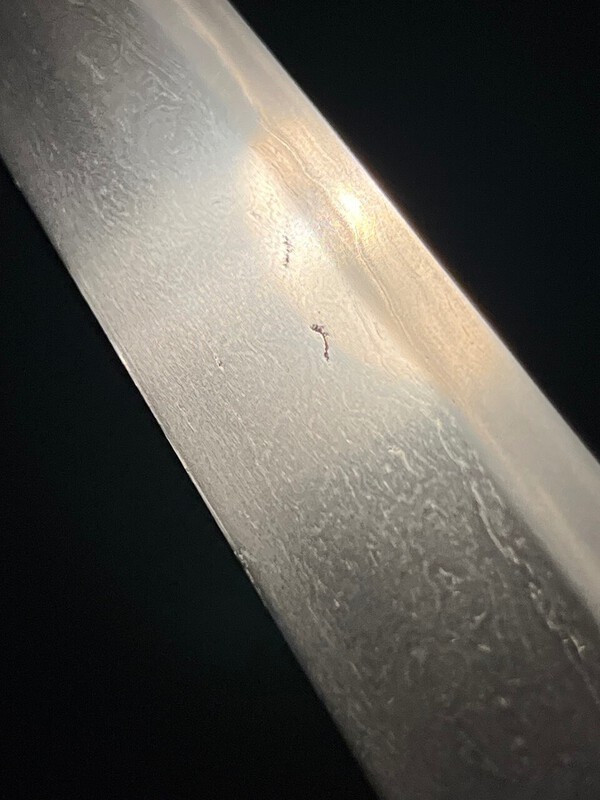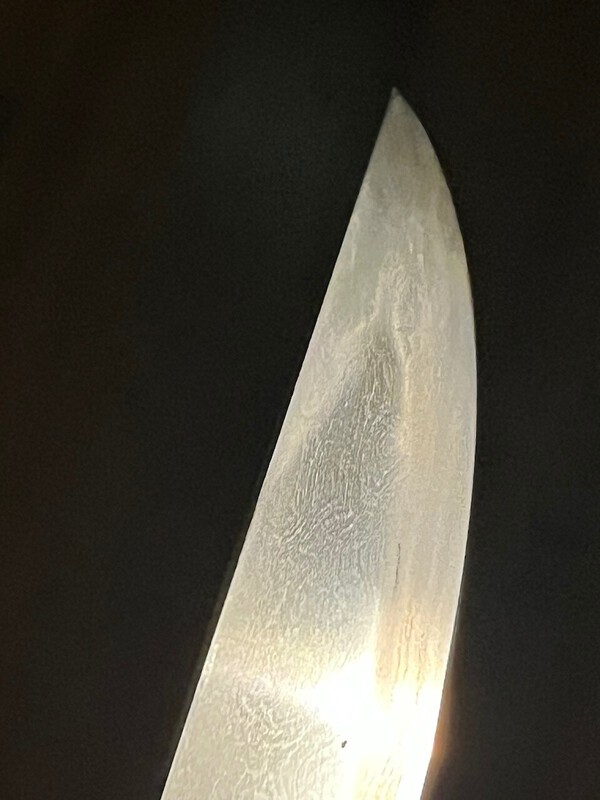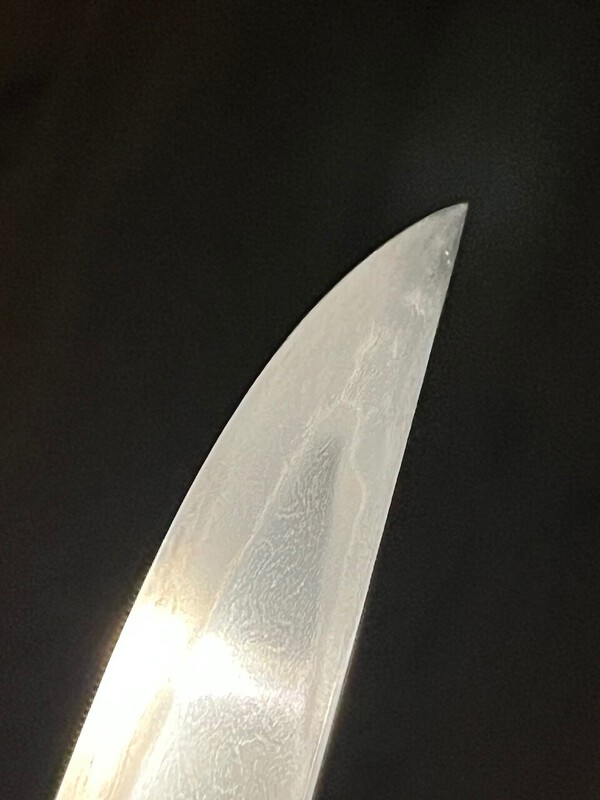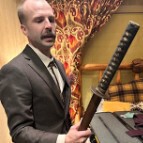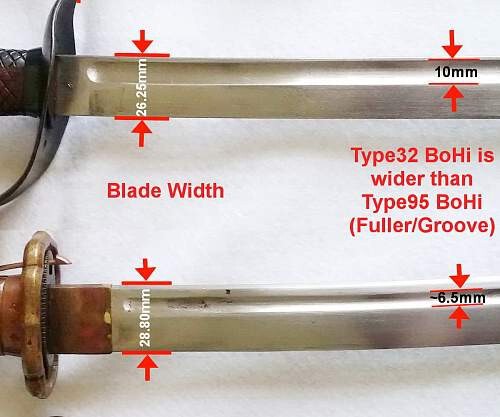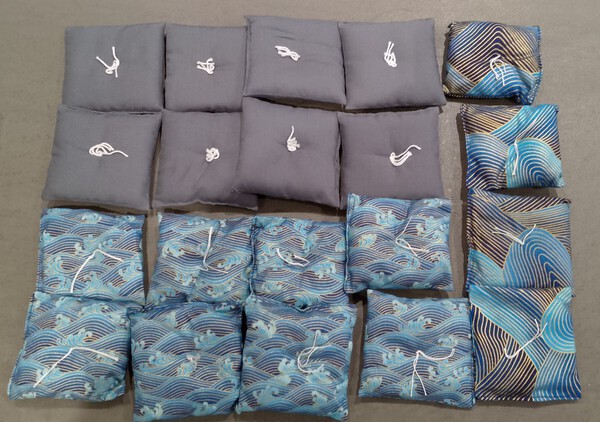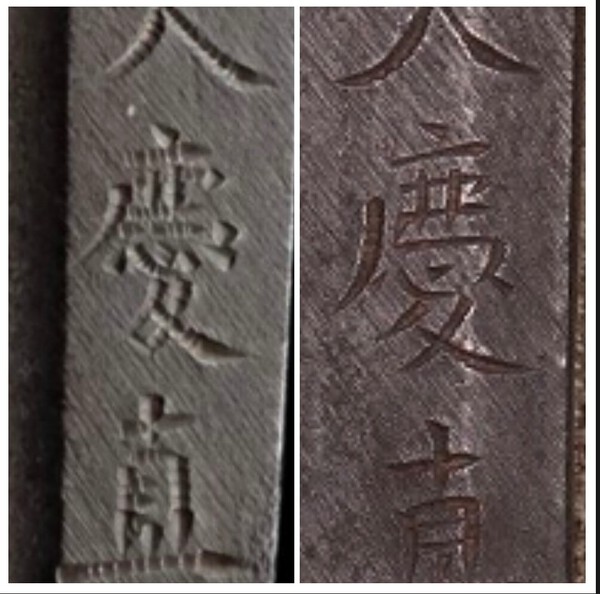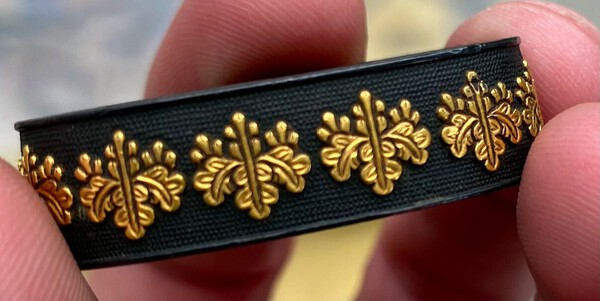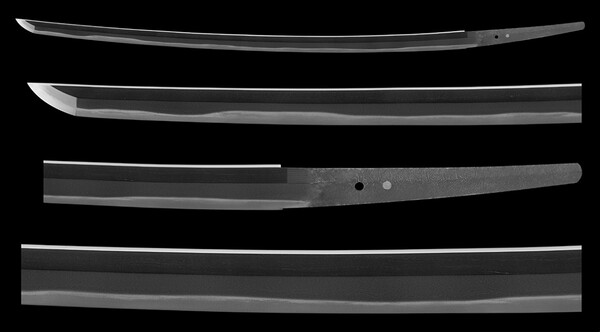Leaderboard
Popular Content
Showing content with the highest reputation on 01/31/2025 in all areas
-
No, this is not some test that needs to be passed. Everything that needed to be said was said. People can make up their own minds now. 3 Pages of this is enough.6 points
-
Jacques and Patrice, For the sake of clarity to forum users, it will be useful to point out that: - the NBTHK certificate uploaded by Patrice is not a qualification diploma or certificate of graduation of a course or training; - it is not a document certifying capability, knowledge, expertise per se in absolute terms etc the way a university degree or technical college diploma might be. No training course and no exams have been taken for these to be conferred (so Jacques, please be careful not to conflate these in your typical attacking mode); - it is a certificate acknowledging that Patrice submitted to the annual NBTHK competition a sword he polished and achieved the rank “nyusen”, the precise interpretation / translation which I am not capable of, but loosely it means something like “his work has been deemed competent enough to be accepted and recognised in this endeavour / exhibition”. I know several European non-traditionally-Japan-trained restorers (in the U.K., Italy etc), who while not formally having completed a full-length Japan-based polishing training period (and thus not having the government diploma of togishi recognition which comes at the end of that training period after passing an official exam) still achieved that “nyusen” recognition. In fact, my Italian friend Massimo has several of these diplomas, which I have seen at his home. These certificates clearly indicate a level of capability and skill recognised to some extent by the NBTHK, and deserve the credit / merit they imply. The “fully traditionally trained”(often Japan-based, but not exclusively) polishers often display skill higher than nyusen, and achieve even higher-rating diplomas and awards. All of that is very public and disclosed in Japanese by both the NBTHK and NBSK (which also organises similar) every year after the awards are granted. But people need to be very clear about what these certificates and achievements are and what these are not. So, I am not defending anyone in the above discussion of what should have been done/said in relation to Catawiki, or taking sides in this debate, but just hoping the above clarifies the matter a bit with regard to such certificates.6 points
-
Robert, there are basically 3 types of so-called Damascus steel. None of them was made or used in Japan for blades. Let me explain: The oldest type of forge-welded steel was made by Celtic people after 800 BC in Europe. It was accidentally made by forge-welding iron of different production places, so the natural content of impurities (Not alloys! These need a liquid state for their production!) like phosphorus could produce a random pattern on the surface when polished and etched with plant acids (tomato juice can act like an acid on carbon-steel). Later, the Vikings became masters in deliberately combining different iron varieties to forge-weld repeatable pattern. Again, that was non-hardenable iron, so the famous Viking swords (look for Sutton Hoo) got a steel cutting edge fire-welded on for good combat performance. What many call "true" Damascus steel came from India and Persia in the early middle ages and was traded to a great content via the old town of Damascus. This steel was made by melting the components at high temperatures in crucibles. It contained a high percentage of carbon (up to almost 2%) plus some secret minerals containing element like Vanadium and Molybdenum. These were necessary to help forming crystals (dendrites) in the steel while cooling. In a difficult process, this crucible Damascus steel (called Wootz in India or Bulat in Russia) was forged out in a lengthy process and when polished and etched, showed repeatable pattern (look for "Mohamed's ladder"). Our modern (industrially or hand-made) forge-welded steel (we should not use the term 'Damascus' for it, but it is too late...) is mostly a combination of high-carbon tool-steels each of which would make for a good cutting tool because of its properties. Most of the time, we combine steels that are promising a good contrast when polished and etched (Manganese containing steel and Nickel-alloyed steel are ideal). This will result in a strong silver/black contrast which we like. In Japan, contrasting metals were used in MOKUME GANE (a soft-metal compound) for decorative purposes, but we also know layered combination (look for GURI BORI). We also know MOKUME GANE (meaning is "looking like wood") made with iron. This is just a non-homogeneous mix of different varieties of iron (again not alloys). When etched, the surface reveals an interesting random pattern, sometimes looking like wood burl.. Japanese blades are made by folding and fire-welding ONE kind of carbon-steel on itself, so you don't get a contrast. What we see as HADA are the welding seams of the many different layers. I won't forget to mention HADA types that show a more defined pattern, caused by deliberately mixing in different steels, but they are rare. For modern industrial Damascus steel, you can choose the different steel components depending on the properties you need. With actual technique and materials, it is rather easy to produce a cheap but decorative so-called Damascus steel which is what is mainly done in India, Pakistan, Bangladesh and China (as far as I know, but there may be more in the meantime!). For a non-expert (to put it mildly), this looks impressive and expensive, and it serves well for just decorative purposes. But is is not Japanese. P.S. This is an abstract and not at all exhaustive6 points
-
河内守藤原国助 / 寛永十九年二月吉日- Kawachi no Kami Kunisuke (first generation) dated 1642, this katana was designated as Jūyō Bijutsuhin [重要美術品]. Now this is outside my preferred old swords, so I thought it would be fun to mix things up. Congratulations to everyone getting the correct result, and some members PM’d me the answer too. The pictures and original text were far from perfect but I am happy so many people participated in the quiz and hopefully everybody had fun doing it. I will try to write somekind of a writeup where I include some references to the answers that were guessed. Unfortunately I do not have enough knowledge to truly discuss the finer details about the differences in guesses. So I will take few quotes by experts. Kawachi no Kami Kunisuke is considered to be one of the founders of Ōsaka-Shintō school. I believe in current theory he comes from Horikawa school with him possibly having roots in Ishidō school. Quote from Nihon Shintō Shi “Unfortunately, the quality of Kunisuke´s works varies. His best blades are on the same level as the great masterworks of the Horikawa school, others are just average Ōsaka-shintō blades. With the 1st generation Kunisuke we can see a reminiscence of a Keichō-shintō-sugata but he mostly made shinogi-zukuri katana and wakizashi in Kanbun-shintō-sugata, i.e. with a shallow sori, a narrow sakihaba and a relatively small kissaki. The jigane is an itame with a tendency to nagare. Ji-nie and chikei appear in Horikawa-style. Naturally he also forged an Ōsaka-jigane with a dense ko-itame and fine ji-nie. The hamon is a notare-gunome mixed with chōji and ashi and the nioiguchi is wide and shows plenty of ko-nie. Some hamon interpretations remind us of Oya-Kunisada. He also applied a suguha or ō-midare but in any case a conspicuous amount of chōji is seen. The bōshi is mostly ko-maru but can run out as yakitsume or show hakikake. He also tempered a midare-komi-bōshi. Kunisuke signed the part „Kawachi no Kami“ smaller than the part „Fujiwara Kunisuke“, but the difference in size decreases over the years. However, this peculiarity is also seen with other shintō smiths. For the sake of differentiation with the 2nd generation, he is also called „Oya-Kunisuke“ (親国助) or „Oya-Kawachi“ (親河内)” Quote from Tōken Bijutsu 654 where a katana by second generation Kunisuke was one of the kantei items at NBTHK HQ. ” But some got the time wrong and went for the shinshintō schools of Yokoyama (横山) and Hosokawa (細川) which are also well known for working in the Bizen tradition. But the Kanbun-shintō-sugata does not match with shinshintō and also the jihada would tend to muji in the latter case. Regarding the hamon, the yakidashi of the Yokoya school does match with Kunisuke but the rhythm of the hamon would be more monotonous and the nioiuchi more compact. On the other hand, a yakidashi is quite rare for the Hosokawa school and also a kobushigata-chōji is totally uncommon for smiths of this lineage.” The above quotes do not relate to this particular sword but I posted them to give reference how works of this smith lineage can be seen. One thing about size is that it is quite common throughout the ages. You can find similar sized tachi and katana.6 points
-
Of course I know you, Mr Descombes, from your bad reputation in the sabre world among serious collectors. You are capable of teaching Tanobe sensei to tell the difference between a Katana and a Tanto. In short, I won't go any further in the discussion with someone like you who is so slanderous, and who has absolutely nothing to contribute. More than anything, I don't see what you're trying to achieve by trying to destroy reputations or by knocking people down. Yes, it's not a diploma but it's already a recognition from the NBTHK and it's very gratifying and gives recognition as a polisher and that's more than enough for me and my customers. So stop talking about me and look after yourselves.4 points
-
4 points
-
*The translator has entered the chat* My gut feeling is that the "to mei ga aru" in this case refers to the Koson signature, and not the Nobufusa attribution. The NBTHK attributed the sword it to Nobufusa, so the "to mei ga aru" only makes sense if it refers to the Koson signature. (Meaning: they doubt Koson wrote the shumei. Or, I should say, they have no consensus about whether or not the Koson shumei is authentic). But, I say this without having consulted with either Tanobe or the NBTHK, and it is just a gut feeling.4 points
-
Another thread on here has been talking about brass type alloys and their appearance/patina. That discussion reminded me of this tsuba that has returned to me having had a short holiday elsewhere🙂 One side has been exposed to the light/atmosphere, the other side shrouded. It looks like it was hung via a very thin thread rather than boxed. The difference is quite spectacular, you would not believe they are sides of the same tsuba made from the same alloy. Anyone beat that for a stark contrast?3 points
-
Well, stepping out of anonymity…… and just the opinions of an old fart etc etc Personally I think porn that veers towards beastiality is pretty damned sick. Calling someone Adolf Hitler displays a remarkable lack of awareness of the difference between a delusional mass murderer and someone trying to moderate a serious forum in a way that is acceptable to most without causing too much offence. Some will always throws toys outa the pram but hey Ho. Images of large cushions shaped as phallus are what I think the little schoolgirls are laughing at on their phones when I drive past them on the way to the gym. Last time l looked in the mirror I wasn’t an arsehole but I have got one and I try not to talk out of it (yes, failing at times I know) Just sayin. Downvote or further insults awaited.3 points
-
I'm posting this one for those trying to learn to spot fakes. It has several things right, which might tempt a new guy to fall for it, like: - Serial number is posted cutting edge down as Tokyo blade should - Latch is curved properly vs the angled bend you see on many fakes - Suya and Kokura stamps aren't bad, in as much as you can see the Suya one - Bohi beginning is a little sloppy but not bad But other things are wrong, first of which, glaringly, is the brass tsuka! These are often sold as a copper handled 95, but they are not. Other issues: - Tokyo stamp on blade is FAR too far from the serial number - Bohi end is not shaped properly for a Tokyo blade - Tokyo inspector stamp on fuchi is really bad - Fine details of tsuka and tsuba dimples, seppa sculpting, kabutogane, are all course, flat; probably an attempt to make it look worn and used - The tsuba has a dark coating to make it look aged Photos at first glance Zooming in for detail:3 points
-
Adding the TH paperwork just for posterity sake as we don’t see many with these sorts of notes. I really appreciate everyone's questions, concerns, and comments. I've learned a lot more than I previously knew both about the smith in question as well as the NBTHK judgement process and so much more. This was my first nihonto purchase after about 18 months of study.3 points
-
Calabrese, concerning the MEI, I absolutely share your opinion that it is odd.3 points
-
David, It looks to be signed Takai 高井Sadatsugu 貞継. Conway3 points
-
3 points
-
I wanted to share my DTI acquisition. I've been experimenting with various photos trying to get the best ones that show off the features of this tachi to the best of my abilities, but I'm very much a novice when it comes to photographing nihonto. The measurements are as follows: Nagasa: 77 cm Sori: 2.6 cm Motohaba: 2.85 cm Sakihaba: 1.52 cm It bears a shumei from Hon'ami Koson. The sayagaki translation is as follows (Thanks to @SteveM for helping me with the translation): 備前國信房 生茎尠シク區ヲ送リ佩表ニ本阿弥光遜ノ同工極ハメノ朱書有之細身、小鋒、腰反高ク踏張ツキ 先身幅ヲ減ジ小鋒ノ華奢ナル形態ヲ呈シ 板目ガ肌立チテ映リ伴フ肌合ニ直刃小乱ヲ焼キ小足入リ小沸付キ湯走細ヤカニカゝリ古様デ静 雅ナ趣ヲ醸シ古備前持味ガ把握サレ所傳ハ妥當ナル優品哉 長弐尺五寸四分 歳甲辰霜月 探山識(花押)2 points
-
Bruce I'm not sure with this that is a fake. I would need better pictures. From my point the nanako is not inverse which shows mostly fakes. The menuki looks sharp. The hi looks nearly correct. The number looks not bad. The seppa has the original looking cherry blossoms on the rim. The clipper looks authentic. I'm not sure. If its fake its one of the best fakes i saw so far. Thanks a lot for showing it Bruce. Really cool. By the way i would not buy it because of its brass tsuka2 points
-
Considering it. I'm far from a prude....very far. But really...does this encourage new members/lady collectors and youth to stay here or are we reduced to looking for a cheap thrill? Not sure exactly what discussion this is supposed to encourage. We already had one high end lady quit the forum over the typical "macho" guy stuff here. I'm asking that we consider this before we post stuff that really isn't all that constructive. Unlike the off topic pictures of huge plushy phallus's that I deleted earlier (and which no doubt led to this post), This one IS kinda antique Japanese art related and I'll leave it up as an example of Shunga for now...but really wonder about your browsing habits and motivation that keep you searching for this stuff online. If you disagree with me, happy to do an anonymous poll and see what the other members think of that?2 points
-
2 points
-
2 points
-
2 points
-
One extra comment. The quality and tight consistency of the material of the initial tsuba in this thread has the same feeling to me as the Shinchu lockwork on many Tanegashima matchlocks. Such shinchu was highly valued at the time.2 points
-
Lovely sword, truly tasteful and classical sugata, well done Chandler. I also applaud that you did your research, that you took a dive on the blade and had a sayagaki made. Koson was more 'loose' in his judgement compared to the Ko-Honami, so it is a good outcome that Tanobe-sensei considers this judgement to be appropriate for the blade. He would not have made it if he disagreed outright. "To mei ga aru" on a shumei or kinzogan has a certain nuanced meaning at Juyo that is different than the same expression used for mei. At Tokuho, there is much less opportunity to carefully research the blade, and in this context "To mei ga aru" could highlight some uncertainty on the shumei/kinzogan itself, as Gakusee points out with an astute observation: In the grand scheme of things it's not really important. As Darcy used to say, we don't have a time machine. To me, this uncertainty is also a blessing in disguise for learning. It is an inspiration for you to take a deep dive into the records of Nobufusa, Ko-Bizen, Ko-Ichimonji, and the wonderful period that was early Kamakura. It is a precious ancient piece with a venerable history, and a miracle that it has come to us in such a state of preservation. May this sword will be a wonderful source of knowledge and enjoyment.2 points
-
Or it could be they doubt how the shu mei exists today. For instance: It could be that “Nobufusa” (very well preserved part of the shumei) was added subsequently above the Koson mei (much less well preserved). In principle, Koson tended to write the attribution on one side of the nakago and put his name and kao on the opposite. That is how I have seen it, including swords I owned. Here everything is on one side and also the different parts look slightly differently. Regardless of all this speculation, it looks like a gorgeous sword and Tanobe sensei seems to have verified it, so all seems good.2 points
-
2 points
-
Often those sites will provide a list of noteworthy families who used a particular crest, but the site I linked to doesn't list any such families, so its a bit of a dead end. But as a side note, family crests were used by multiple families, so its often difficult/impossible to pinpoint a crest on a sword to any one family.2 points
-
Yes, Thomas has it. I'll post the kanji as I'd just done the translation myself: 濃州関住小島勝正作2 points
-
Hi Max, Your sword appears to be signed NOSHU SEKI (no) JU KO-JIMA KATSU MASA SAKU. Tom M.2 points
-
Emil: In the pics below, I have noted the issues folks are talking about, for future reference, and to help you spot some common signs of a fake. This first pic shows the acid etched logo, the Damascus pattern steel (not common in Japanese swords), and the misaligned machi (should be straight across). The second pic shows the sharply cut and unrefined nakago jiri and the off angle of the nakago. The third pic shows the overly sharp angle of the kissaki. Japanese swords are more elegant and refined. Hope this helps, John C.2 points
-
Patrice, You've never had a job in Public Relations have you? When you get to the bottom of a hole, it's generally better to put the spade down and start looking for a ladder. The one thing missing from any of your posts are the words "I'm sorry, I made a mistake," instead there is the constant deflection from the error that you made towards the "haters". If you expect to find any love around here for those involved in selling dodgy items on internet platforms you've badly misjudged your audience. Being charitable, from the "cut and paste" in your last post it looks like you may be using an on-line translator so some of what you are saying might come across differently if you were writing in your first language but your aggressive tone is probably doing more to trash your reputation than the original mistake. Everybody makes them, it is how they are dealt with that makes the difference and you aren't dealing with it very well.2 points
-
Yours is a combination of the two above. The literal translation is "five-spline fan with three-tomoe, in a circle". Tomoe is the motif of the comma-shaped marks. https://myoji-kamon.net/kamonDetail.htm?kamonName=丸に五本骨扇に三つ巴2 points
-
Gents, a sturdy tanto, a long yoroi doshi. Comes in shirasaya, with nice copper habaki. NBTHK has attributed it to Uda Tomotsugu, while NTHK thought it is a Bizen Osafune Kiyomitsu. You decide what works best. Nagasa 25.4 cm Motohaba 24.8 mm Motokasane 6.4 mm Hada: itame nagare Hamon: nie deki, sunagashi, nice big formations of nie I think it is this sword smith (from Sesko's Index): TOMOTSUGU (友次), 5th gen., Tenbun (天文, 1532-1555), Etchū – “Etchū no Kuni Kawasaki-jū Tomotsugu saku” (越中国河崎住友次作), “Hikokurō saku Tomotsugu” (彦九郎作友次), first name Hikokurō (彦九郎), he signed also with his place of residence, that is to say Kawasakimura (川崎村) written as (河崎) without “mura” (村, “village”), he was active from Tenbun to Eiroku (永禄, 1558-1570), most of the extant Uda-Tomotsugu blades go back to this generation, the jigane is a standing-out itame-nagare, the hamon is a gunome in ko-nie-deki mixed with ko-midare and sunagashi, the nioiguchi is subdued, chū-jō-saku SOLD1 point
-
Thanks to everyone's input, we are up to 35 known examples! So far, I think it's the most complete list out there (though not speaking Japanese, I can't be certain how many other lists survive somewhere else). In addition, patterns are starting to emerge suggesting which inspectors were working at which time and when inspector stamp placement started to change. As of yet, however, I have not been able to translate the seal scripts to get a sense of inspector names. Still researching that part. Here is the updated serial number list: 325, 487, 575, 1539, 1996, 2379, 2522, 3397, 3587, 4077, 4429, 5578, 5988, 6251, 6784, 8170, 8572, 8782, 9090, 9536, 9777, 10781, 11448, 11871, 13121, 13197, 14013, 14323, 14408, 15383, 15773, 16019, 16065, 16416, Unk serial number sold on Worthpoint. (35 as of 1-31-25) Again, I appreciate all the input for this project. John C.1 point
-
I agree about the kissaki, and I'm inclined to believe it's a fake... Although, fakes this good are concerning! Something to consider about 95 blade geometry is that there are reports that some Type32 blades were converted for 95 use. Allegedly they were reshaped and reformed to closer mimic the 95 specs. I have personally never seen an example of this - and I don't think this sword is one. But my point is: judging on blade geometry alone can be tricky. This "brass tsuka" sword is one of those potential fakes that I'd really like to see in-hand. Cheers, -Sam1 point
-
1 point
-
Ah, I see. The members who don't want to see posts headed "Ejaculating adolescent watching two copulating turtles" are self righteous hypocritical old fart assholes. I see. Who knew? Personally, I got over online porn and cheap thrills 25 years ago, but hey....we can suggest some free online porn sites if that's your thing? I can see we are too old, hypocritical and self righteous for you here. Perhaps it's time to check out some of the forums with lesser morals.1 point
-
1 point
-
1 point
-
Hi Dave, I really don't want to rain on your parade but, as @nulldevice said, Naotane is a BIG name and repeatedly copied. I'd hold off on plastering his name all over your photos. On the left is the mei of a Tokubetsu Hozon verified Naotane (link below), on the right yours. Apart from the fact the genuine article is signed tachimei and yours katanamei, can you see the obvious differences? Dee https://www.samuraim...u-hozon-certificate/1 point
-
1 point
-
It is a new IAITO TSUBA in my eyes, what ever it is made of and how, but I bet it is not by a traditional method.1 point
-
Well, I don’t know where to post this so I decided to add it to this thread. Unfortunately, I walk with a cane (age bites!). I have made a couple of my own canes. I had an extra purple heart cane blank that I bought years ago. I had a reproduction tsuka that I also bought years ago. So, I mounted the tsuka on the cane using a 3/16 dowel that was pre-drilled in the purple heart cane blank and then drilled a 3/16 hole in the tsuka. I superglued everything together. There is some tiny movement in the tsuka cane handle due to the ito wrap. But it still works fine. Onward!1 point
-
The green tsuka ito appears from time to time. I’ve seen quite a few on Iijima swords. I guess a question it raises for me is whether the tsuka for Type 95s were made in-house by the subcontractors or provided from an external supplier. Conway1 point
-
Hi John, I can't speak to the layering, construction, or mei. But, in my opinion, this is a good example of what not to look for in NANAKO. And it was the first thing I noticed. Quality nanako will look almost impossibly precise, and be evenly applied. Whereas the tsuba in your photo looks like the nanako dots are randomly scattered without any pattern. Image of shakudo nanako fuchi from my collection. All the best, -Sam1 point
-
1 point
-
1 point
-
Really gorgeous sword, Chandler. I enjoyed handling it quite a bit, and got to thinking after the show, I think it’s the oldest sword that I’ve ever held! I didn’t have the chance to really dive into identifying hataraki, but the dramatic sugata, the ko-kissaki, and the general refinement of the hamon and hada was enjoyable to admire. Your sword really stood out amongst the others at the show as something special. All in all, what’s not to like? Well done! -Sam1 point
-
If you set yourself up as a high profile expert and you are paid for that role then you really need to be able to perform it. “Not enough time” or “genuine mistake” is no use to buyers who find themselves scammed or mislead. It is very demanding role, not something to be undertaken unless you really know the full range of what you are evaluating or certifying. Being kind and nice just doesn’t cut it in this harsh business…..sadly. I speak as an ex-consulatant for an auction house. I wish you well as a polisher, I suspect you will be much happier.1 point
-
Hi Athanasios, Welcome to the forum. Unfortunately, (and I don't mean to be dismissive, so please don't take offence) you might already know as much about the blade as you are going to. The problem with shinshinto, and to some extent shinto, blades is that they often lack any distinguishing characteristics that can help to place them geographically or within a particular school so it is going to be difficult to tell you much more about an unsigned blade from this timeframe than you already know. If it helps, there's nothing there that suggests that it is anything other than as described so you at least have the genuine article. Did it come with any kind of scabbard or other fittings? The habaki looks like it is better quality than normal so that is encouraging as someone thought enough about it to give it more than a basic outfit and I find the overall shape quite graceful and easy on the eye which is not the case with all blades from this period so I think that those are positive points. What might help when you have a moment is if you are able to take some photographs of the blade as scanned images tend to obscure details. If you are able to do that in a darkened room with a single point of light, place the blade on something soft and on a flat surface and you will be able to move the blade around in the light to reveal the details that are there. If you are able to post some pictures of the detail in the hamon, hada and boshi you may get some better comments. Apologies for not being more helpful and, once again, welcome to NMB and this fascinating hobby and congratulations on your new blade.1 point
-
I aim these comments primarily at newer collectors. From "New Gen. of Jap. S/smiths" by Tamio Tsuchiko p.216 and 218 hadori is "whitening inside the hamon and drawing the hamon line" and the accepted originator of this type of polish was one of the surviving lines of the Hon'ami after the Haitorei into about 1930s. Nakahara pp.83-85 discusses this hadori and describes sashikomi as a polish that brings out "all the blades features" and follows the true hamon line. Broken down to its simplest form...sashikomi allows the acrivity to be clearly seen when looking directly at the side of the blade while hadori is a misty white edge that does not reveal anything until in hand and pointed at the light...this is why one can't tell anything by looking at pics of hadori blades in NBTHK papers and nihonto books....this is why papers and dealers always include an oshigata, so you can see the true features. As an old "geezer" who began collecting in the 70s the hadori polish was rarely seen in swords currently in the west. I now find that to the new generation of collectors post 1980s, hadori is the norm in sword polish. For this reason, I thought it might be interesting and helpful to discuss the two polishes and their contemporary eras. (I am open to mistakes and corrections of course). I can say from MY experience that in the post-war years one never saw hadori in the UK and Australia. 99% of blades were polished in sashikomi. In all my years of collecting I can only point to two blades (gendaito) with hadori and in both cases (rjt smiths) the hamon is so active with nijuba, hotsure etc that really, the only polish possible in rushed wartime conditions was a suguba style hadori. All the others, including "souvenir" koto, shinto swords from occupied Japan still in pre-war polishes it was very rare to see hadori. It therefore separates us into immediate postwar collectors and post 1980s collectors...in fact, one reason why I turned away from nihonto of all ages to being more or less "WWII gendaito only" is the polish. In 1980 when I first went to Japan and saw lots of swords in museums, all? the "recently" restored blades looked exactly the same (look in amy modern book of pics)...all white painted husseys in hadori haha...the only swords I remember particularly are the Yokoyama smith works still in sashikomi in shrines and old displays. As to being "true" to bringing out the sword's features I think it can be said that hadori is often used to hide flaws that would certainly appear in sashikomi...that is why it is called kessho (cosmetic). this must be an important point to consider. Look at the two pics here and say honestly what their particular attractions are and what you consider as necessary features to be visible in a sword and whether both polishes show these (I have chosen two swords with essentially the same hamon). I am not trying to be offensive here...I have shown my preferences and why, and it would be nice to discuss other preferences and why. Please feel free to relate polish to other forms of display art, such as paintings etc. Let me say here that I am puzzled at the almost total swing to hadori polish...is it because newer members aren't aware of "what was"? Are newer members just following the "modern trend?...is hadori really a "must have" and "the best"? Personally I don't think so and I am concerned that the art of sashikomi will be lost...hopefully, all new collectors might become "re-interested" in sashikomi and insist on ordering some sashikomi polishes before this happens. Hope this is of some interest.1 point
-
I think each polish has it's place. For me kesho polish is best used on a hamon were the nioi-guchi is not neatly formed (niju-ba, hotsure, etc.). Here is a Sendai Kunikane polished by Mishina san as an example of what I mean. His use of hadori brings the hamon together well, and makes it look more uniform. As Franco said, a good polish is a good polish, but I also think maybe kesho polish is overused today.1 point
This leaderboard is set to Johannesburg/GMT+02:00

